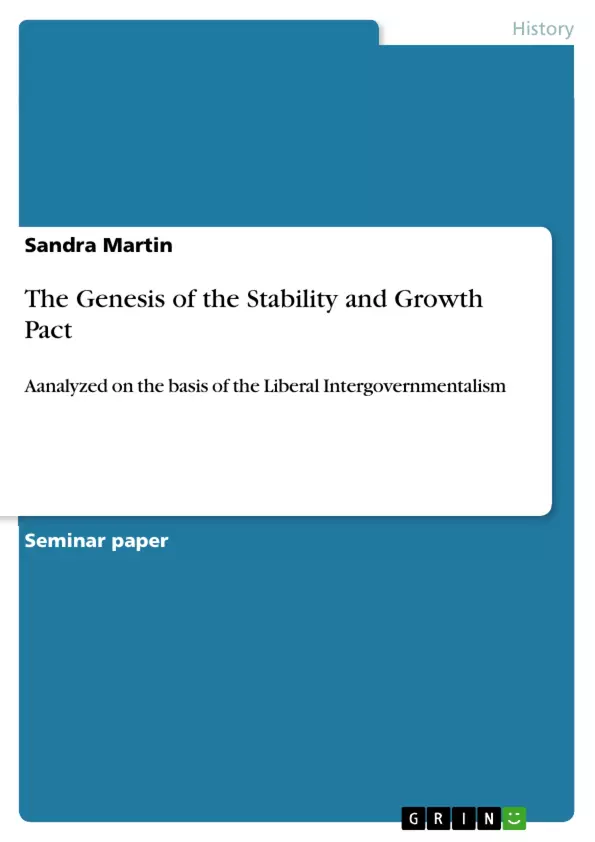The implementation of the European Economic and Monetary Union (EMU), with a common European currency was one of the most far-reaching integration-steps of the European Integration. The EMU was enacted in 1992 with the Treaty of Maastricht and envisaged its implementation in three stages. Thereby the member states should gradually transfer competences and controlling tools to the European level and further the coordination of their monetary and economic policies. The purpose of the EMU was a uniform monetary policy for all member states, whereas the fiscal policies remain at the national level. With the approach of the third stage the integration process got into stumble und the project of a common European currency threatened to fail. Only after the ratification of an additional agreement – the Stability and Growth Pact – all of the European member states agreed to enter into the last stage of the EMU. Without this stability pact the implementation of the EMU would have been remained unfinished.
This pact was not intended in the Maastricht Treaty, but constitutes an amendment to it. Wherefrom did the demand for this additional agreement come and how were the negotiations taking place? The genesis of the Stability and Growth Pact (SGP) will be analyzed in this paper. Thereby I concentrate on the two countries Germany and France. These were the dominant actors, who influenced and determined the development of the pact. The theoretical frame for the analysis is the Liberal Intergovernmentalism by Andrew Moravcsik. This integration theory focuses on “grand bargains“ between nation states to explain the steps of the process of the European Integration. In the following chapters I will firstly carve out the relevant aspects of Moravcsik´s theory. Afterwards the theory is applied to explain the genesis of the SGP.
Inhaltsverzeichnis (Table of Contents)
- Introduction
- Liberal Intergovernmentalism by Andrew Moravcsik
- The Genesis of the Stability and Growth Pact
- National preference formation of Germany and France
- Bargaining process and institutional choice
- Conclusion
Zielsetzung und Themenschwerpunkte (Objectives and Key Themes)
This paper aims to analyze the genesis of the Stability and Growth Pact (SGP), focusing on the roles of Germany and France as key actors in its development. The analysis utilizes the Liberal Intergovernmentalism theory by Andrew Moravcsik, which emphasizes the role of national preferences, interstate bargaining, and institutional choice in shaping European integration.
- The role of national preferences in shaping the SGP
- The dynamics of interstate bargaining between Germany and France
- The significance of institutional choice in the implementation of the SGP
- The application of the Liberal Intergovernmentalism framework to explain the SGP's emergence
- The impact of the SGP on the European Economic and Monetary Union (EMU)
Zusammenfassung der Kapitel (Chapter Summaries)
- Introduction: This chapter introduces the Stability and Growth Pact (SGP) as a crucial element in the implementation of the European Economic and Monetary Union (EMU). It highlights the need for the SGP as a means to ensure the stability of the EMU and addresses the origins and significance of the pact.
- Liberal Intergovernmentalism by Andrew Moravcsik: This chapter provides an overview of Andrew Moravcsik's Liberal Intergovernmentalism theory, which serves as the theoretical framework for analyzing the genesis of the SGP. The chapter discusses the key principles of the theory, including the focus on national preferences, interstate bargaining, and institutional choice.
- The Genesis of the Stability and Growth Pact: This chapter delves into the specific process of the SGP's formation, concentrating on the roles of Germany and France as dominant actors. It examines the national preference formation of these two countries, their interactions in the bargaining process, and the resulting institutional choice.
Schlüsselwörter (Keywords)
This paper focuses on the genesis of the Stability and Growth Pact (SGP), examining its key actors, national preferences, interstate bargaining, institutional choice, and impact on the European Economic and Monetary Union (EMU). The paper utilizes the Liberal Intergovernmentalism theory by Andrew Moravcsik as its theoretical framework.
- Quote paper
- Sandra Martin (Author), 2014, The Genesis of the Stability and Growth Pact, Munich, GRIN Verlag, https://www.grin.com/document/344510



